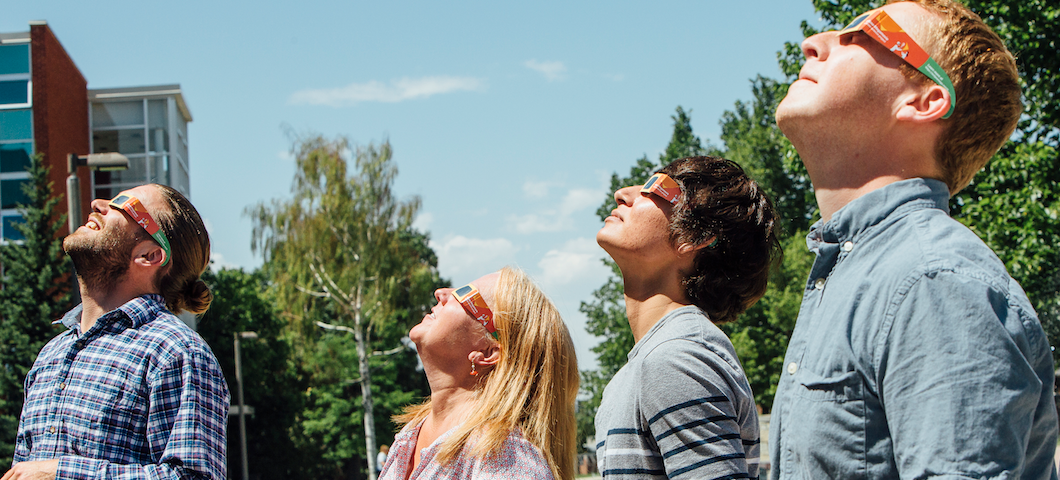Eclipse viewing information
Weather permitting, the 2017 total solar eclipse on Aug. 21 will be an awe-inspiring phenomenon to experience. The last total solar eclipse that was visible from the contiguous U.S. occurred in 1979; the next ones won’t take place until 2024 and 2045.
A total solar eclipse, in which the moon completely obscures the sun and produces the most dramatic effect, will be visible from a roughly 70-mile-wide area stretching from Oregon to South Carolina. See these maps that show the path of totality. Viewers in the Bozeman area will see a less dramatic partial eclipse in which the moon will cover about 95 percent of the sun.
In Bozeman, the partial eclipse will begin at roughly 10 a.m. and will peak at 11:36 a.m.
Eclipse safety
Even during an eclipse, looking at the sun can cause permanent eye damage. In the Bozeman area, where viewers will see the partial eclipse, it will be necessary to wear protective glasses the entire time. Only within the zone of totality during the roughly two minutes of totality can viewers safely look at the eclipse without protective eyewear. More information about safety can be found on this NASA website.
Glasses are inexpensive and are available online. It’s important to purchase glasses that comply with international safety standard ISO 12312-2. Doing a google search for "ISO 12312-2 eclipse glasses" produces several inexpensive options.
Glasses are available at the MSU Library (limit 2 per person). Check availability by calling 994-3139.
The Bozeman Public Library and some other libraries in the area also have a limited number of free glasses. Inquire about availability. The Bozeman Public Library can be reached at 582-2400.
Travel to totality
Eclipse Ballooning Project director Angela Des Jardins is encouraging people to try and visit the zone of totality, because seeing a total solar eclipse is an awe-inspiring, once-in-a-lifetime experience.
The MSU Eclipse Ballooning Project team will be traveling to the Rexburg, Idaho, area to launch their three balloons that will transmit the livestream. From there they will view the dramatic total solar eclipse (weather permitting), in which the moon will cast an eerie darkness, stars will emerge in the daytime sky and a 360-degree sunset will appear.
However, the MSU team is expecting crowded highways before, during and after the eclipse. Accommodations in the area have long been booked. The team is planning alternative ways to communicate in the event that cellphone infrastructure fails due to high demand. Des Jardins recommends that people choosing to visit the zone of totality be prepared to handle summer heat and bring plenty of water and food.
Watching the livestream
The video taken from high-altitude balloons during the eclipse will be livestreamed to NASA's website. The video, taken from roughly 80,000 feet, will show the moon's shadow traversing the Earth, the curvature of the planet and the blackness of space. According to Des Jardins, this is the first time that aerial video of a total solar eclipse will be livestreamed using high-altitude balloons. MSU's video will be livestreamed on this webpage on this website.
According to Des Jardins, the livestream is meant to complement viewing the eclipse directly, not replace the experience. She recommends viewing the livestream during the hour before or after the local peak of the eclipse. Teams will be livestreaming from more than a dozen balloons in Oregon and Idaho before the eclipse peaks in Bozeman.
MSU viewing events
On Monday, August 21, members of the MSU Physics Department will be hosting a viewing party in front of the MSU Library starting at 10 a.m. There will be eclipse glasses available, as well as solar telescopes and other special viewing equipment. Inside the library, large screens will display the livestream from the Eclipse Ballooning Project.
The Museum of the Rockies will show the Eclipse Ballooning Project livestream at the Taylor Planetarium. Doors open at 10 a.m. and normal admission charges apply. Eclipse glasses will also be available for purchase.

